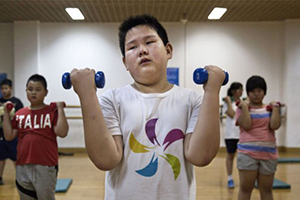
China's child obesity problem could be big business for Fashion Industry
YarnsandFibers News Bureau 2019-05-22 17:45:00 – ChinaNearly 20% of Chinese children ages 7 to 18 are overweight or obese, up from 2.6% in 1985.
Factors driving that trend include rising family incomes, changing eating habits and cultural notions of what's healthy.
As a result, the market for larger kids' clothing is expected to be worth $9.1 billion by 2020.
Chinese children are becoming more overweight and their expanding waistlines correlate with a growth opportunity for the fashion industry. The cause of the alarming health trend? Blame doting grandparents, rising incomes and cultural attitudes around food for Chinese youngsters' poor health and eating habits.
The phenomenon is supported by the latest available data: In 2014, 19.4% of children ages 7 to 18 in China were overweight or obese, up from 2.6% in 1985, according to the Obesity Report for China, published by the Institute of Child and Adolescent Health at Peking University and other organizations. More than a third of those children were considered obese.
The trend is expected to continue heading in the same direction: By 2030, 28% of Chinese children are expected to be overweight, or obese, according to the same report.
While this could mean more doctors' visits for the country's younger population, it represents a multi-billion dollar opportunity for retailers in the children's fashion industry, which is expected to be valued at $35.9 billion by the end of the year. Retailers that cater to bigger Chinese children stand to claim significant marketshare: The market for larger children's clothing is expected by worth approximately $9.1 billion by 2020, a Coresight Research report found, citing data from Euromonitor International.
Less acceptance in China?
Big American retailers including Target and Kohl's have already started catering to larger children. There is, however, skepticism around whether Chinese retailers will be as eager to embrace the opportunity.
"On the one hand there is this opportunity for more plus-size fashion and models, but on the other hand, in China, there isn't necessarily the same acceptance of larger-sized people that there is in the U.S.," said Hazel Clark, professor of design studies and fashion studies at Parsons School of Design.
She said established retailers are best-positioned to introduce new fabrics and styles in a range of sizes to be inclusive of all children -- and capitalize on a fast-growing opportunity.
"Now, because so many people are shopping online, one could set up as a niche, larger-size childrenswear brand online and probably work more effectively than if one had to open a brick-and-mortar store," she said. "Because so many middle- and upper-class people in China are shopping online."
In 2018, more than 610 million people in China had purchased goods online, compared to 74 million in 2008, according to Statista.
The Chinese economy is now the world's second-largest after the U.S. Yet its rapid growth has contributed to the rise in obesity among children, with families making -- and spending -- more money on food. The annual per-person expenditure on food in China for urban households has grown ten-fold over nearly three decades. In 2017, that figure was $1,044.80, compared to $103.50 in 1990, according to China's National Bureau of Statistics.
Grandparent effect
Older Chinese people in particular, many of whom experienced periods of poverty and food shortages, may be indulgent now that they can afford to be. "Now they have more money to spend, so they want more food. The more the better, and they have the wrong perception of what healthy eating is," said Bai Li, research fellow at the University of Birmingham in the United Kingdom.
And it's not just the amount of food that's driving overeating. "The way they cook, it's high in fat, sugar and oil and all contributes to high caloric intake in children," Li said.
She said grandparents in particular bear responsibility for the uptick in childhood obesity. "They have a lot of control over how the child should be looked after, particularly in terms of feeding," she said.
Couple more food consumption with less physical activity -- thanks to the internet -- and kids' body-mass indices go up.
American retailers including Target, which has expanded its size ranges for children and adults, and Kohl's, which in March launched its own plus-size label for juniors are already well-versed in catering to plus-sized bodies. This could give them an advantage overseas, but they have yet to test the waters in China and have no immediate plans to do so despite their "built-in advantage for expansion into the Chinese market," according to Charlie Poon, a Hong Kong-based analyst at Coresight Research and author of the report.
Big Chinese retailers also appear to be leaving money on the table, according to Poon. But some small to medium-sized children's retailers including Xiaozhu Tuoni and Moregoto have already started claiming market share by "tapping into the plus size market in China," Poon said.
Courtesy: CBS News
Market Intelligence
Ask for free sample Report

experience
Customer Base
dedicated team
Countries Served Worldwide









